Principles of Modern Radar, Vol. I: Basic Principles
Brief Contents
Contents
Preface
Goals of the Book
Organization of Content
Features and Resources
Companion Publications
Acknowledgments
Errors and Suggestions
Publisher Acknowledgments
Master Reviewers
Technical Reviewers
Editors and Contributors
Volume Editors
Chapter Contributors
List of Acronyms
List of Common Symbols
PART I: Overview
1 James A. Scheer, William A. Holm: Introduction and Radar Overview
1.1 Introduction
1.2 The Radar Concept
1.3 The Physics of EM Waves
1.3.1 Wavelength, Frequency, and Phase
1.3.1.1 Wavelength
1.3.1.2 Frequency
1.3.1.3 Phase
1.3.1.4 Superposition (Interference)
1.3.2 Intensity
1.3.3 Polarization
1.4 Interaction of EM Waves with Matter
1.4.1 Diffraction
1.4.2 Atmospheric Attenuation
1.4.3 Atmospheric Refraction
1.4.4 Reflection
1.5 Basic Radar Configurations and Waveforms
1.5.1 Monostatic versus Bistatic
1.5.2 Continuous Wave versus Pulsed
1.5.2.1 CW Waveform
1.5.2.2 Pulsed Waveform
1.5.3 Noncoherent versus Coherent
1.5.3.1 The Doppler Shift
1.5.3.2 Unambiguous Doppler Shift Measurement
1.6 Noise, Signal-to-Noise Ratio, and Detection
1.7 Basic Radar Measurements
1.7.1 Target Position
1.7.2 Range Rate and Doppler Frequency Shift
1.7.3 Polarization
1.7.4 Resolution
1.8 Basic Radar Functions
1.8.1 Search/Detect
1.8.2 Track
1.8.3 Imaging
1.9 Radar Applications
1.9.1 Military Applications
1.9.1.1 Search Radars
1.9.1.2 Air Defense Systems
1.9.1.3 Over-the-Horizon Search Radars
1.9.1.4 Ballistic Missile Defense (BMD) Radars
1.9.1.5 Radar Seekers and Fire Control Radars
1.9.1.6 Instrumentation/Tracking Test Range Radars
1.9.1.7 Tracking, Fire Control, and Missile Support Radars
1.9.1.8 Multifunction Radars
1.9.1.9 Artillery Locating Radars
1.9.1.10 Target Identification Radars
1.9.2 Commercial Applications
1.9.2.1 Process Control Radars
1.9.2.2 Airport Surveillance Radars
1.9.2.3 Weather Radars
1.9.2.4 Wake Vortex Detection Radars
1.9.2.5 Marine Navigation Radars
1.9.2.6 Satellite Mapping Radars
1.9.2.7 Police Speed Measuring Radars
1.9.2.8 Automotive Collision Avoidance Radars
1.9.2.9 Ground Penetration Radars
1.9.2.10 Radar Altimeters
1.10 Organization of This Text
1.11 Further Reading
1.12 References
1.13 Problems
2 James A. Scheer: The Radar Range Equation
2.1 Introduction
2.2 Power Density at a Distance R
2.3 Received Power from a Target
2.4 Receiver Thermal Noise
2.5 Signal-to-Noise Ratio and the Radar Range Equation
2.6 Multiple-Pulse Effects
2.7 Summary of Losses
2.7.1 Transmit Loss
2.7.2 Atmospheric Loss
2.7.3 Receive Loss
2.7.4 Signal Processing Loss
2.8 Solving for Other Variables
2.9 Decibel Form of the Radar Range Equation
2.10 Average Power Form of the Radar Range Equation
2.11 Pulse Compression: Intrapulse Modulation
2.12 A Graphical Example
2.13 Clutter as the Target
2.14 One-Way (Link) Equation
2.15 Search Form of the Radar Range Equation
2.16 Track Form of the Radar Range Equation
2.17 Some Implications of the Radar Range Equation
2.18 Further Reading
2.19 References
2.20 Problems
3 James A. Scheer: Radar Search and Overview of Detection in Interference
3.1 Introduction
3.2 Search Mode Fundamentals
3.2.1 Search Volume
3.2.2 Total Search Time
3.2.3 Phased Array Antenna Issues
3.2.4 Search Regimens
3.2.4.1 Track-while-Scan
3.2.4.2 Search-and-Track
3.3 Overview of Detection Fundamentals
3.3.1 Overview of the Threshold Detection Concept
3.3.2 Probabilities of False Alarm and Detection
3.3.3 Noise PDF and False Alarms
3.3.4 Signal-Plus-Noise PDF: Target Detection
3.3.5 Receiver Operating Curves
3.3.6 Fluctuating Targets
3.3.7 Interference Other than Noise
3.3.8 Some Closed-Form Solutions
3.3.8.1 Approximate Detection Results for a Nonfluctuating Target
3.3.8.2 Swerling 1 Target Model
3.3.9 Multiple-Dwell Detection Principles: Cumulative PD
3.3.10 m-of-n Detection Criterion
3.4 Further Reading
3.5 References
3.6 Problems
PART II: External Factors
4 Jay A. Saffold: Propagation Effects and Mechanisms
4.1 Introduction
4.2 Propagation Factor
4.3 Propagation Paths and Regions
4.3.1 Monostatic and Bistatic Propagation
4.3.2 The Surface
4.3.3 The Atmosphere
4.4 Atmospheric Attenuation and Absorption
4.4.1 Clear Air Water Vapor
4.4.2 Rain
4.4.3 Fog
4.4.4 Snow and Hail
4.4.5 Dust
4.4.6 Smoke
4.5 Atmospheric Refraction
4.5.1 Standard Refraction
4.5.2 Anomalous Refraction
4.6 Turbulence
4.7 Exploiting the Ionosphere
4.8 Diffraction
4.9 Multipath
4.9.1 Propagation Paths and Superposition
4.9.2 Describing the Reflecting Surface
4.9.3 The Multipath Reflection Coefficient
4.9.3.1 Fresnel Reflection Coefficients
4.9.3.2 Divergence Factor
4.9.3.3 Roughness Factors
4.9.3.4 Angle Error
4.9.3.5 Classification Error
4.10 Skin Depth and Penetration: Transmitting Through Walls
4.11 Commercial Simulations
4.12 Summary and Further Reading
4.13 References
4.14 Problems
5 Nicholas C. Currie: Characteristics of Clutter
5.1 Introduction and Definitions
5.1.1 What Is Clutter?
5.1.2 Comparison of Clutter and Noise
5.1.3 Basic Definitions
5.1.3.1 Scattering Coefficients
5.1.3.2 Clutter Polarization Scattering Matrix
5.2 General Characteristics of Clutter
5.2.1 Overview
5.2.2 Surface Clutter
5.2.2.1 General Dependencies
5.2.2.2 Temporal and Spatial Dependencies
5.2.2.3 Average Value Data
5.2.2.4 Clutter Variability Properties
5.2.3 Atmospheric Clutter
5.2.3.1 Average Value Data
5.2.3.2 Temporal Spectra
5.2.4 Millimeter Wave Clutter
5.3 Clutter Modeling
5.3.1 General Approaches for Estimating Detection Performance in Clutter
5.3.2 Clutter Models
5.3.2.1 Surface Clutter
5.3.2.2 Atmospheric Clutter Models
5.4 Concluding Remarks
5.4.1 Reflectivity Summary
5.4.2 Clutter Effect on Detection
5.5 Further Reading
5.6 References
5.7 Problems
6 John F. Shaeffer: Target Reflectivity
6.1 Introduction
6.2 Basic Reflection Physics
6.2.1 Electromagnetic Wave Fundamentals
6.2.2 Electromagnetic Wave Polarization
6.2.2 Electromagnetic Wave Reflection
6.3 Radar Cross Section Definition
6.3.1 IEEE RCS Definition
6.3.2 Intuitive Derivation for Scattering Cross Section
6.3.3 RCS Customary Notation
6.3.4 Polarization Scattering Matrix
6.3.4.1 Scattering Matrix for Linear Polarization
6.3.4.1 Scattering Matrix for Circular Polarization
6.4 Three Scattering Regimes
6.4.1 Rayleigh Region Dipole Scattering
6.4.2 Resonant Region Scattering
6.4.3 High-Frequency Optics Region
6.5 High-Frequency Scattering
6.5.1 Phasor Addition
6.5.2 Specular Scattering
6.5.3 End-Region Scattering
6.5.4 Edge Diffraction
6.5.5 Multiple-Bounce Scattering
6.6 Examples
6.7 Further Reading
6.8 References
6.9 Problems
7 Mark A. Richards: Target Fluctuation Models
7.1 Introduction
7.2 Radar Cross Section of Simple Targets
7.2.1 Basic Scatterers
7.2.2 Aspect Angle and Frequency Dependence of RCS
7.3 Radar Cross Section of Complex Targets
7.4 Statistical Characteristics of the RCS of Complex Targets
7.4.1 RCS Distributions
7.4.2 RCS Correlation Properties
7.5 Target Fluctuation Models
7.5.1 Swerling Models
7.5.2 Extended Models of Target RCS Statistics
7.6 Doppler Spectrum of Fluctuating Targets
7.7 Further Reading
7.8 References
7.9 Problems
8 William A. Holm, Mark A. Richards: Doppler Phenomenology and Data Acquisition
8.1 Introduction
8.2 Doppler Shift
8.3 The Fourier Transform
8.4 Spectrum of a Pulsed Radar Signal
8.4.1 Spectrum of a Continuous Wave Signal
8.4.2 Spectrum of a Single Rectangular Pulse
8.4.3 Infinite Pulse Train
8.4.4 Finite Pulse Train
8.4.5 Modulated Finite Pulse Train
8.4.6 Pulsed Waveform Spectrum with Moving Targets
8.4.7 Doppler Resolution
8.4.8 Receiver Bandwidth Effects
8.5 Why Multiple Pulses?
8.6 Pulsed Radar Data Acquisition
8.6.1 Video Detectors and Phase Shift
8.6.2 Coherent Detector
8.6.3 Range Bins
8.6.4 Pulsed Radar Data Matrix and Datacube
8.7 Doppler Signal Model
8.7.1 Measuring Doppler with Multiple Pulses
8.7.2 Coherent Pulses
8.8 Range-Doppler Spectrum for a Stationary Radar
8.8.1 Elements of the Doppler Spectrum
8.8.2 Range-Doppler Spectrum
8.9 Range-Doppler Spectrum for a Moving Radar
8.9.1 Clutter Spreading
8.9.2 Clutter Spectrum Elements
8.9.3 Range-Doppler Clutter Distribution
8.9.4 Range and Velocity Ambiguity Effects
8.10 Further Reading
8.11 References
8.12 Problems
PART III: Subsystems
9 Christopher D. Bailey: Radar Antennas
9.1 Introduction
9.2 Basic Antenna Concepts
9.2.1 The Isotropic Antenna
9.2.2 The Radiation Pattern
9.2.3 Beamwidth
9.2.4 Directivity and Gain
9.2.5 Sidelobes
9.3 Aperture Tapers
9.4 Effect of the Antenna on Radar Performance
9.5 Monopulse
9.6 Reflector Antennas
9.7 Phased Array Antennas
9.7.1 The Array Factor
9.7.2 Phase Shifters
9.7.3 Grating Lobes
9.7.4 Gain Loss
9.7.5 The Array Element
9.7.6 Wideband Phased Arrays
9.8 Array Architectures
9.8.1 Passive Array Architecture
9.8.2 Active Array Architecture
9.8.3 Subarray Architecture
9.9 Further Reading
9.10 References
9.11 Problems
10 Tracy V. Wallace, Randy J. Jost, and Paul E. Schmid: Radar Transmitters
10.1 Introduction
10.1.1 The Radar Transmitter as Part of the Overall Radar System
10.1.1.1 Basic Pulse Radar
10.1.1.2 Phased Array Radar
10.1.2 Radar Transmitter Parameters
10.2 Transmitter Configurations
10.3 Power Sources and Amplifiers
10.3.1 Oscillators
10.3.1.1 Magnetron Oscillators
10.3.1.2 Gyrotron Oscillators
10.3.1.3 Solid-State Oscillators
10.3.2 Tube Amplifiers
10.3.2.1 Linear Beam Tubes: Klystrons
10.3.2.2 Linear Beam Tubes: Traveling Wave Tubes
10.3.2.3 Cross-Field Tubes: Crossed-Field Amplifier
10.3.3 Solid-State Sources
10.3.3.1 Solid-State Amplifiers
10.3.3.2 Solid-State Transmitter/Receiver Modules
10.3.3.3 Solid-State Active-Aperture Arrays
10.3.4 Microwave Power Modules
10.4 Modulators
10.4.1 Line-Type Modulators
10.4.2 Active-Switch Modulators
10.5 Power Supplies
10.5.1 High-Voltage Power Supplies
10.5.2 Power Supplies for Solid-State Amplifiers
10.6 Transmitter Impacts on the Electromagnetic Environment
10.6.1 Transmitter Design and Spectrum Issues
10.6.2 Transmitter Impacts on Spectral Purity
10.6.2.1 Time-Varying Errors
10.6.2.2 Nontime-Varying Errors
10.7 Operational Considerations
10.7.1 Transmitter Reliability
10.7.2 Transmitter Cooling
10.7.3 Safety Issues
10.8 Summary and Future Trends
10.9 Further Reading
10.10 References
10.11 Problems
11 Joseph A. Bruder: Radar Receivers
11.1 Introduction
11.2 Summary of Receiver Types
11.2.1 Crystal Video Receiver
11.2.2 Superregenerative Receivers
11.2.3 Homodyne Receivers
11.2.4 Superheterodyne Receivers
11.2.5 Digital Receivers
11.2.6 Instantaneous Frequency Measurement Receivers
11.2.7 Channelized Receivers
11.3 Major Receiver Functions
11.3.1 Receiver Protection
11.3.2 RF Preselection
11.3.3 Frequency Downconversion and Mixers
11.3.4 Selection of LO and IF Frequencies
11.4 Demodulation
11.4.1 Noncoherent Demodulation
11.4.2 Coherent Demodulation
11.4.3 Analog Coherent Detection Implementation and Mismatch Errors
11.5 Receiver Noise Power
11.6 Receiver Dynamic Range
11.6.1 Sensitivity Time Control
11.6.2 Gain Control
11.6.3 Coupling Issues
11.7 Analog-to-Digital Data Conversion
11.7.1 Spurious-Free Dynamic Range
11.7.2 Direct Digital Coherent Detection Implementation
11.7.3 Digital Up/Down Frequency Conversion
11.8 Further Reading
11.9 References
11.10 Problems
12 James A. Scheer: Radar Exciters
12.1 Introduction
12.2 Exciter-Related Radar System Performance Issues
12.2.1 Phase Noise Issues
12.2.1.1 Spectral Folding Effects
12.2.1.2 Self-Coherence Effect
12.2.2 Effect of Phase Noise on Clutter Reduction—MTI Processing
12.2.3 Effect of Phase Noise on Pulse-Doppler Processing
12.2.4 Effect of Phase Noise on Imaging
12.3 Exciter Design Considerations
12.3.1 Transmit Signal
12.3.2 Waveform Generation
12.4 Exciter Components
12.4.1 Stable Oscillators-Oscillator Technology
12.4.2 Synthesizers
12.4.3 Other Devices
12.4.3.1 Assembly Approaches
12.4.3.2 Mixers
12.4.3.3 Switches
12.4.3.4 Frequency Multipliers
12.4.3.5 Frequency Dividers
12.4.3.6 Amplifiers
12.5 Timing and Control Circuits
12.6 Further Reading
12.7 References
12.8 Problems
13 Mark A. Richards: The Radar Signal Processor
13.1 Introduction
13.2 Radar Processor Structure
13.3 Signal Processor Metrics
13.3.1 Hardware Metrics
13.3.2 Algorithm Metrics
13.4 Counting FLOPS: Estimating Algorithm Computational Requirements
13.4.1 General Approach
13.4.2 Mode-Specific Formulas
13.4.3 Choosing Efficient Algorithms
13.5 Implementation Technology
13.5.1 Analog-to-Digital Conversion
13.5.2 Processor Technologies
13.5.3 COTS Technology and Modular Open Architectures
13.5.4 The Influence of Moore’s Law
13.6 Fixed Point versus Floating Point
13.7 Signal Processor Sizing
13.7.1 Considerations in Estimating Timing
13.7.2 Benchmarks
13.7.3 Software Tool Impacts
13.7.4 Data Rates
13.7.5 Onboard versus Offboard Processing
13.8 Further Reading
13.9 References
13.10 Problems
PART IV: Signal and Data Processing
14 Mark A. Richards: Digital Signal Processing Fundamentals for Radar
14.1 Introduction
14.2 Sampling
14.2.1 The Nyquist Sampling Theorem
14.2.2 Sampling Nonbaseband Signals
14.2.3 Vector Representation of Sampled Signals
14.2.4 Data Collection and the Radar Datacube
14.3 Quantization
14.4 Fourier Analysis
14.4.1 The Discrete-Time Fourier Transform
14.4.2 Windowing
14.4.3 Spatial Frequency
14.4.4 The Discrete Fourier Transform
14.4.5 Straddle Loss
14.4.6 The Fast Fourier Transform
14.4.7 Summary of Fourier Transform Relationships
14.5 The z Transform
14.6 Digital Filtering
14.6.1 Spectral Representations of LSI Systems
14.6.2 Digital Filter Characteristics and Design
14.6.2.1 FIR Filters
14.6.2.2 IIR Filters
14.6.2.3 Filter Design Comparison Example
14.6.3 Implementing Digital Filters
14.6.4 Shift-Varying and Nonlinear Systems
14.7 Random Signals
14.7.1 Probability Density Functions
14.7.2 Moments and Power Spectrum
14.7.3 White Noise
14.7.4 Time Averages
14.8 Integration
14.8.1 Coherent Integration
14.8.2 Noncoherent Integration
14.9 Correlation as a Signal Processing Operation
14.10 Matched Filters
14.11 Further Reading
14.12 References
14.13 Problems
15 Mark A. Richards: Threshold Detection of Radar Targets
15.1 Introduction
15.2 Detection Strategies for Multiple Measurements
15.3 Introduction to Optimal Detection
15.3.1 Hypothesis Testing and the Neyman-Pearson Criterion
15.3.2 The Likelihood Ratio Test
15.4 Statistical Models for Noise and Target RCS in Radar
15.4.1 Statistical Model of Noise
15.4.2 Statistical Models of Radar Cross Section for Targets
15.4.3 RCS Decorrelation Properties
15.4.4 Swerling Models
15.4.5 Extended Models of Target RCS Statistics
15.4.6 Statistics of Targets in Interference and the Detection Statistic
15.5 Threshold Detection of Radar Signals
15.5.1 Unknown Parameters
15.5.2 The Optimum Detector for Nonfluctuating Radar Signals, One Sample
15.5.3 Performance for the Nonfluctuating Signal in Gaussian Noise, N =1
15.5.4 Optimum Detector for Nonfluctuating Radar Signals with Coherent Integration
15.5.5 Optimum Detector for a Nonfluctuating Target with Noncoherent Integration
15.5.6 Linear and Square Law Detectors
15.5.7 Square Law Detector Performance for a Nonfluctuating Target, N > 1
15.5.8 Albersheim’s Equation
15.5.9 Fluctuating Targets
15.5.10 Frequency Agility
15.5.11 Shnidman’s Equation
15.5.12 Detection in Clutter
15.5.13 Binary Integration
15.6 Further Reading
15.7 References
15.8 Problems
16 Byron Murray Keel: Constant False Alarm Rate Detectors
16.1 Introduction
16.2 Overview of Detection Theory
16.3 False Alarm Impact and Sensitivity
16.4 CFAR Detectors
16.4.1 Review of the Neyman-Pearson Square Law Detector
16.4.2 Basic CFAR Architecture
16.5 Cell Averaging CFAR
16.5.1 CA-CFAR Performance
16.5.2 Homogeneous Performance
16.5.3 CFAR Loss
16.5.4 CA-CFAR Performance in Heterogeneous Environments
16.5.4.1 Masking
16.5.4.2 Clutter Boundaries
16.6 Robust CFARs
16.6.1 Greatest-of CA-CFAR
16.6.2 Suppression of Mutual Target Masking
16.6.2.1 Smallest-of CA-CFAR
16.6.2.2 Trimmed Mean or Censored CFAR
16.6.2.3 Order Statistics CFAR
16.6.2.4 CS- and OS-CFAR Numerical Example
16.6.3 Combining GO with CS or OS
16.7 Algorithm Comparison
16.8 Adaptive CFARs
16.9 Additional Comments
16.9.1 Non-Rayleigh Backgrounds
16.9.2 Clutter Map CFAR
16.10 Further Reading
16.11 References
16.12 Problems
17 Mark A. Richards: Doppler Processing
17.1 Introduction
17.2 Review of Doppler Shift and Pulsed Radar Data
17.2.1 Doppler Shift
17.3 Pulsed Radar Doppler Data Acquisition and Characteristics
17.4 Moving Target Indication
17.4.1 Pulse Cancellers
17.4.2 Blind Speeds and Staggered PRFs
17.4.3 MTI Figures of Merit
17.4.4 Limitations to MTI Performance
17.4.5 MTI from a Moving Platform
17.5 Pulse-Doppler Processing
17.5.1 The Discrete-Time Fourier Transform of a Constant-Velocity Target
17.5.2 Sampling the Doppler Spectrum and Straddle Loss
17.5.3 Signal-to-Noise Ratio in the Doppler Spectrum
17.5.4 Matched Filter and Filterbank Interpretations of Pulse-Doppler Processing with the DFT
17.5.5 Fine Doppler Estimation
17.5.6 Modern Spectral Estimation in Pulse-Doppler Processing
17.5.7 Metrics for Pulse-Doppler Detection of Moving Targets
17.5.8 Dwell-to-Dwell Stagger
17.5.9 Blind Zones
17.5.10 PRF Regimes and Ambiguity Resolution
17.5.11 Transient Effects
17.6 Clutter Mapping and the Moving Target Detector
17.6.1 Clutter Mapping
17.6.2 The Moving Target Detector
17.7 Pulse Pair Processing
17.8 Further Reading
17.9 References
17.10 Problems
18 W. Dale Blair, Mark A. Richards, David G. Long: Radar Measurements
18.1 Introduction
18.2 Precision and Accuracy in Radar Measurements
18.2.1 Precision and Accuracy
18.2.2 Accuracy and Performance Considerations
18.3 Radar Signal Model
18.4 Parameter Estimation
18.4.1 Estimators
18.4.2 The Cramèr-Rao Lower Bound
18.4.3 Precision and Resolution for the Gaussian Case
18.4.4 Signal and Target Variability
18.5 Range Measurements
18.5.1 Resolution and Sampling
18.5.2 Split-Gate and Centroid Range Measurement
18.6 Phase Measurement
18.7 Doppler and Range Rate Measurmements
18.7.1 DFT Methods
18.7.2 DFT Interpolation Methods
18.7.3 Pulse Pair Estimation
18.8 RCS Estimation
18.9 Angle Measurements
18.9.1 Angle Centroiding for Scanning Radars
18.9.2 Monopulse AOA Estimation
18.9.2.1 Single Target
18.9.2.2 Multiple Unresolved Targets
18.10 Coordinate Systems
18.11 Further Reading
18.12 References
18.13 Problems
19 W. Dale Blair: Radar Tracking Algorithms
19.1 Introduction
19.2 Basics of Track Filtering
19.2.1 Parametric Estimation
19.2.1.1 Constant Velocity Filtering
19.2.1.2 Constant Acceleration Filtering
19.2.2 Stochastic State Estimation
19.2.2.1 Nearly Constant Velocity Filtering with DWNA
19.2.2.2 Nearly Constant Velocity Tracking with LFM Waveforms
19.2.2.3 Nearly Constant Velocity Filtering with CWNA
19.2.2.4 Nearly Constant Acceleration Filtering
19.2.2.5 Multiple Model Filtering for Highly Tracking Maneuvering Targets
19.3 Kinematic Motion Models
19.3.1 Nearly Constant Velocity Motion Model
19.3.2 Nearly Constant Acceleration Motion Model
19.3.3 Singer Motion Model
19.3.4 Nearly Constant Speed Motion Model
19.4 Measurement Models
19.4.1 Measurements in Stabilized Coordinates
19.4.2 Measurements in Sine Space
19.4.3 Measurements with LFM Waveforms
19.4.4 Surveillance Radars with Measurements of Reduced Dimension
19.5 Radar Track Filtering
19.5.1 Nonlinear Least Squares Estimation
19.5.2 Extended Kalman Filter
19.5.3 Converted Measurement Filter
19.6 Measurement-to-Track Data Association
19.6.1 Formation of a New Track
19.6.2 Measurement Validation and Gating
19.6.3 Nearest Neighbor Filter
19.6.4 Strongest Neighbor Filter
19.6.5 Probabilistic Data Association Filter (PDAF)
19.7 Performance Assessment of Tracking Algorithms
19.8 Further Reading
19.9 References
19.10 Problems
20 Byron Murray Keel: Fundamentals of Pulse Compression Waveforms
20.1 Introduction
20.2 Matched Filters
20.2.1 Relevance of SNR to Radar Performance
20.2.2 Energy Form of the Radar Range Equation
20.2.3 The Form of the Matched Filter
20.2.4 Point Target Model
20.2.5 Match Filtered Response Proportional to Waveform Energy
20.2.6 Fourier Relationships and the Matched Filter
20.2.7 Derivation of the Matched Filter
20.2.8 The Radar Range Equation and Matched Filter Relationship
20.2.9 The Match Filtered Response for a Simple Pulse
20.2.10 Properties of the Match Filtered Response
20.3 Range Resolution
20.3.1 Resolution as Defined by the Rayleigh Criterion
20.3.2 Resolution Defined in Terms of Mainlobe Width
20.3.3 Woodward’s Range Resolution Constant
20.3.4 The Relationship between Bandwidth and Range Resolution
20.3.5 An Examination of Resolution Using Two Point Targets
20.4 Straddle Loss
20.5 Pulse Compression Waveforms
20.5.1 Amplitude Modulation
20.5.2 Frequency Modulation
20.5.3 Phase-Coded Waveforms
20.6 Pulse Compression Gain
20.7 Linear Frequency Modulated Waveforms
20.7.1 Time-Domain Description of an LFM Waveform
20.7.2 Waveform Spectrum
20.7.3 Compressed Response
20.7.4 Rayleigh Resolution
20.7.5 The Nominal Sidelobe Response
20.8 Matched Filter Implementations
20.8.1 Dispersive Filters
20.8.2 Digital Filters
20.9 Sidelobe Reduction in an LFM Waveform
20.9.1 Weighting and Time-Bandwidth Requirements
20.9.2 Straddle Loss Reduction
20.10 Ambiguity Functions
20.10.1 Ambiguity Function for a Simple Pulse
20.10.2 Ambiguity Function for an LFM Waveform
20.10.3 Range-Doppler Coupling
20.10.4 Spectral Interpretation of Range-Doppler Coupling
20.10.5 Dealing with Doppler Modulation in a Pulse Compression Waveform
20.10.6 The V-LFM
20.11 LFM Summary
20.12 Phase-Coded Waveforms
20.12.1 The Structure and General Properties of Phase-Coded Waveforms
20.12.2 Phase Codes Used in Radar
20.12.3 Phase Modulation
20.12.4 Equivalence Operations
20.12.5 Match Filtered Response of a Phase Code
20.12.6 Spectrum of a Phase-Coded Waveform
20.12.7 Doppler Tolerance
20.13 Biphase Codes
20.13.1 Biphase Barker Codes
20.13.2 MPS codes
20.13.3 Maximal Length Sequences
20.13.4 Comparison of MLS and LFM Waveform Responses and Spectra
20.14 Polyphase Codes
20.14.1 Polyphase Barker Codes
20.14.2 Frank, P1, and P2 Codes
20.14.3 P3 and P4 Codes
20.15 Phase-Code Summary
20.16 Further Reading
20.17 References
20.18 Problems
21 Gregory A. Showman: An Overview of Radar Imaging
21.1 Introduction
21.2 General Imaging Considerations
21.2.1 SAR as a Large Synthetic Antenna Aperture
21.2.2 SAR as Range-Doppler Imaging
21.2.3 SAR as a Signal Processing Exercise
21.3 Resolution Relationships and Sampling Requirements
21.3.1 Resolution Relationships
21.3.2 Synthetic Aperture Sampling Requirements
21.3.3 Miscellaneous Relationships
21.4 Data Collection
21.5 Image Formation
21.5.1 SAR Coordinate Systems
21.5.2 Linear Collection PSR
21.5.3 DBS Derivation
21.5.4 DBS Image Formation
21.5.5 DBS, Doppler, and the PSR
21.5.6 DBS Example
21.5.7 DBS Limitations
21.5.8 Matched Filter Imaging
21.5.9 Image Formation Survey
21.6 Image Phenomenology
21.6.1 No Return Areas
21.6.2 Shadowing
21.6.3 Foreshortening and Layover
21.6.4 Speckle
21.6.5 Man-Made Returns
21.6.6 Signal-to-Noise and Clutter-to-Noise Ratios
21.7 Summary
21.8 Further Reading
21.9 References
21.10 Problems .
Appendix A: Maxwell’s Equations and Decibel Notation
A.1 Maxwell’s Equations
A.2 The Ubiquitous dB
A.3 Reference
Appendix B: Answers to Selected Problems
Index
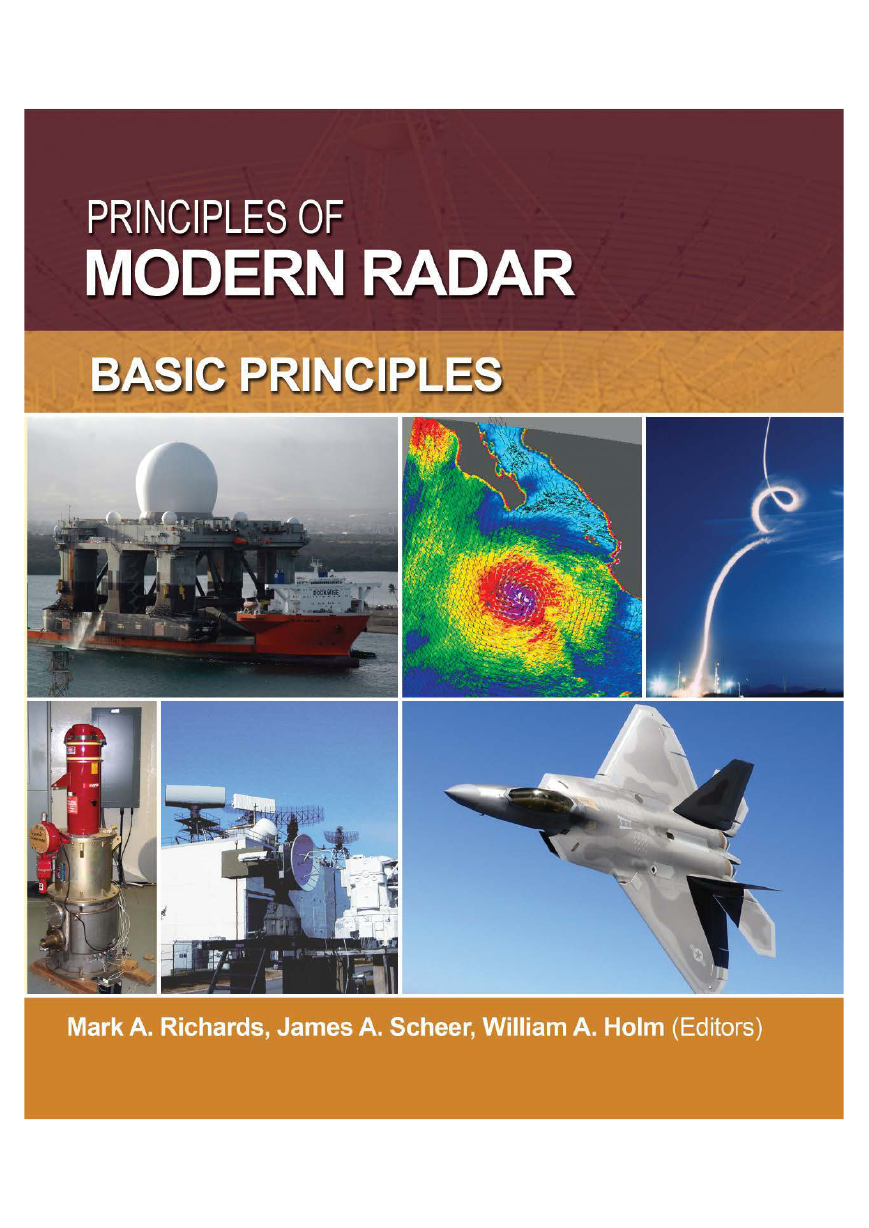
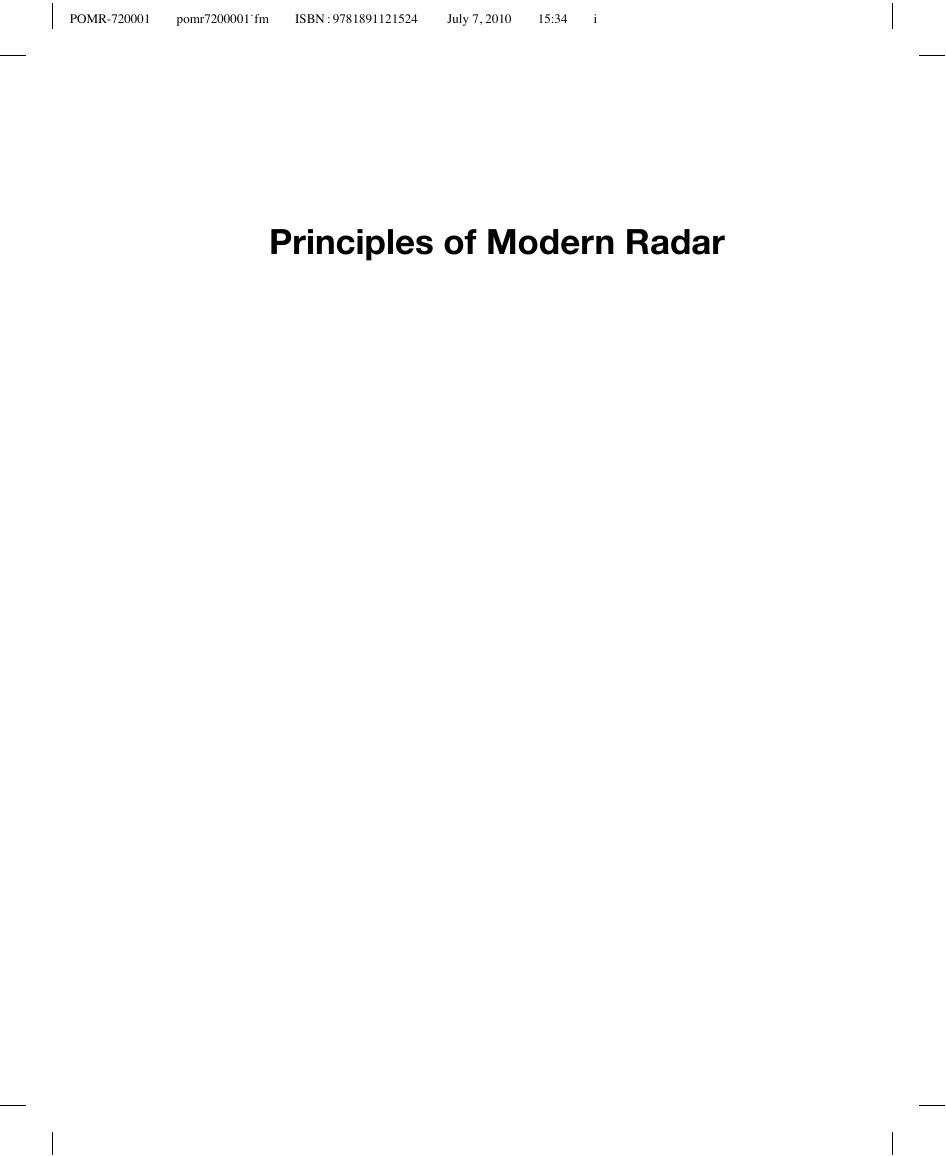

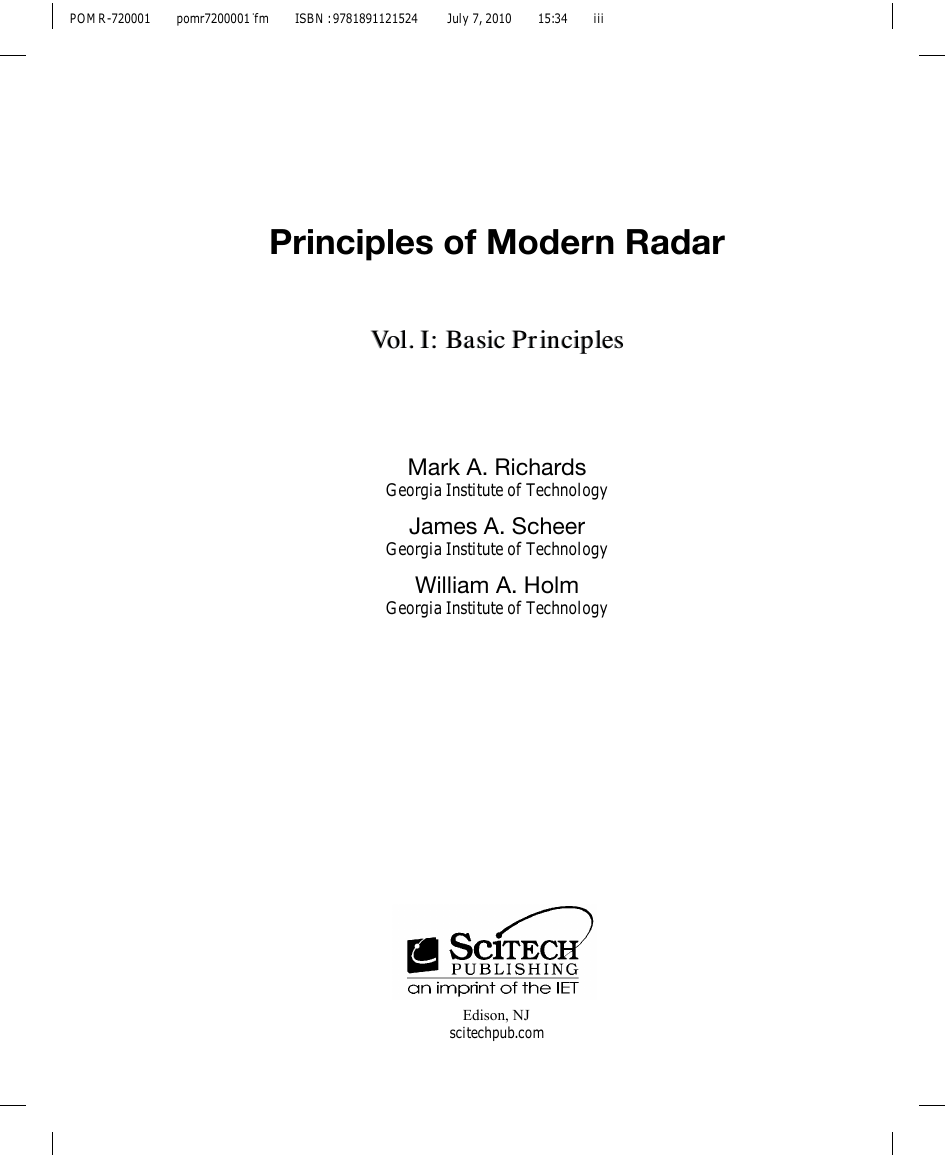
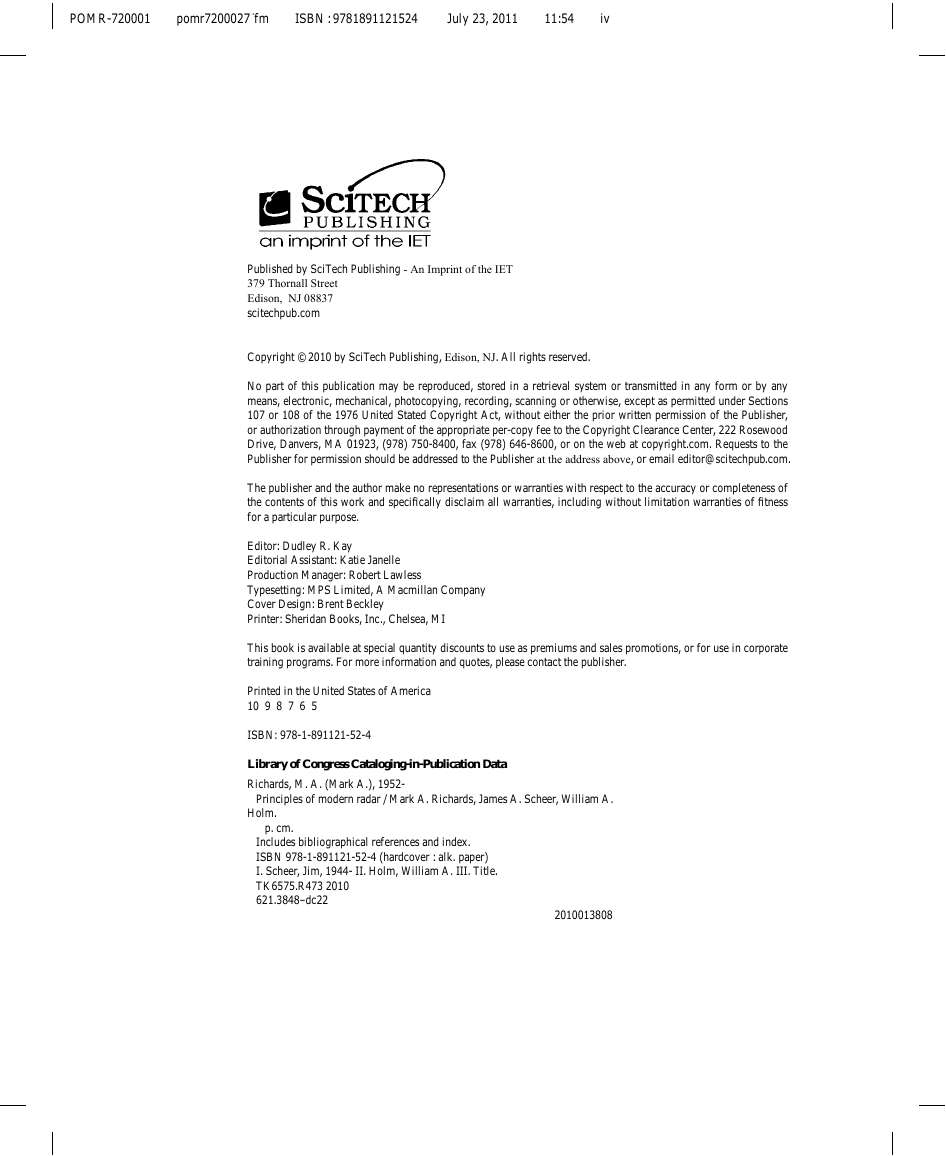


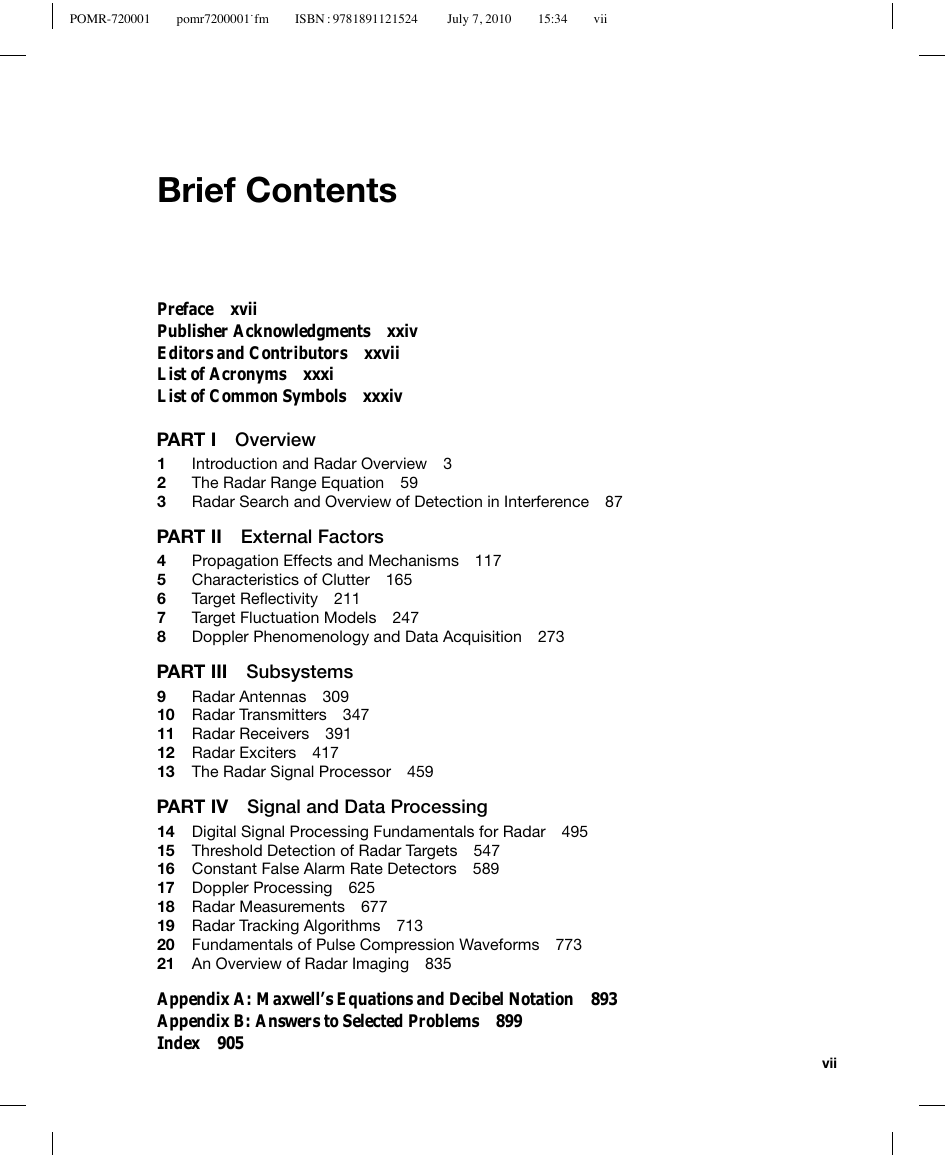








 2023年江西萍乡中考道德与法治真题及答案.doc
2023年江西萍乡中考道德与法治真题及答案.doc 2012年重庆南川中考生物真题及答案.doc
2012年重庆南川中考生物真题及答案.doc 2013年江西师范大学地理学综合及文艺理论基础考研真题.doc
2013年江西师范大学地理学综合及文艺理论基础考研真题.doc 2020年四川甘孜小升初语文真题及答案I卷.doc
2020年四川甘孜小升初语文真题及答案I卷.doc 2020年注册岩土工程师专业基础考试真题及答案.doc
2020年注册岩土工程师专业基础考试真题及答案.doc 2023-2024学年福建省厦门市九年级上学期数学月考试题及答案.doc
2023-2024学年福建省厦门市九年级上学期数学月考试题及答案.doc 2021-2022学年辽宁省沈阳市大东区九年级上学期语文期末试题及答案.doc
2021-2022学年辽宁省沈阳市大东区九年级上学期语文期末试题及答案.doc 2022-2023学年北京东城区初三第一学期物理期末试卷及答案.doc
2022-2023学年北京东城区初三第一学期物理期末试卷及答案.doc 2018上半年江西教师资格初中地理学科知识与教学能力真题及答案.doc
2018上半年江西教师资格初中地理学科知识与教学能力真题及答案.doc 2012年河北国家公务员申论考试真题及答案-省级.doc
2012年河北国家公务员申论考试真题及答案-省级.doc 2020-2021学年江苏省扬州市江都区邵樊片九年级上学期数学第一次质量检测试题及答案.doc
2020-2021学年江苏省扬州市江都区邵樊片九年级上学期数学第一次质量检测试题及答案.doc 2022下半年黑龙江教师资格证中学综合素质真题及答案.doc
2022下半年黑龙江教师资格证中学综合素质真题及答案.doc